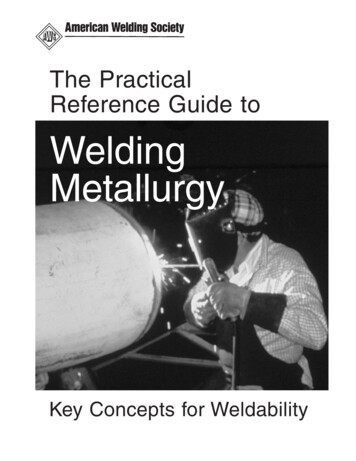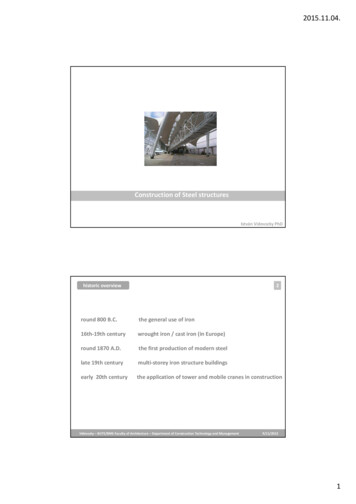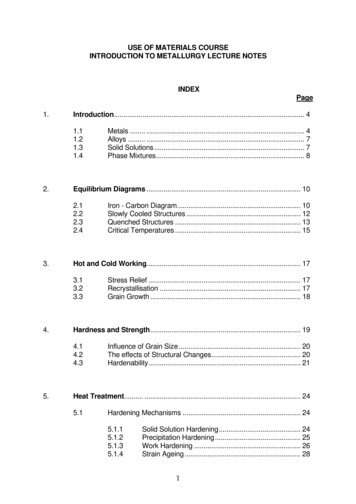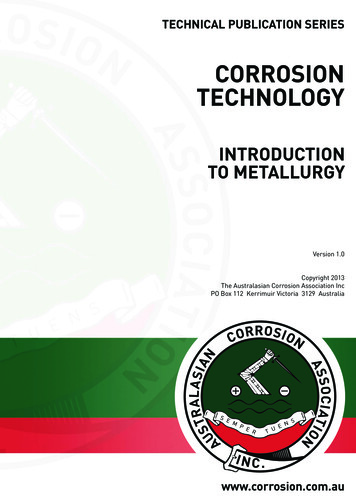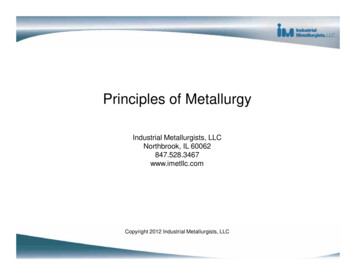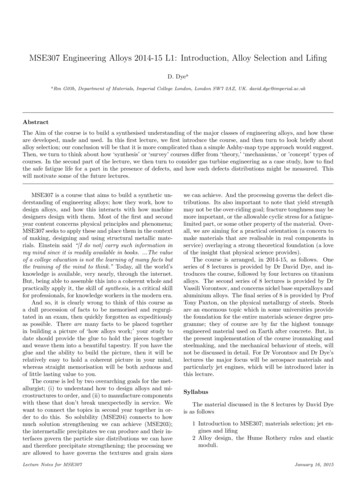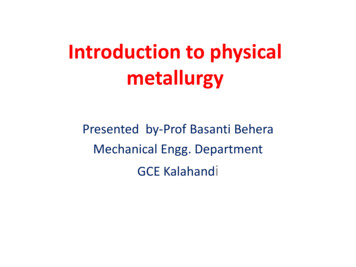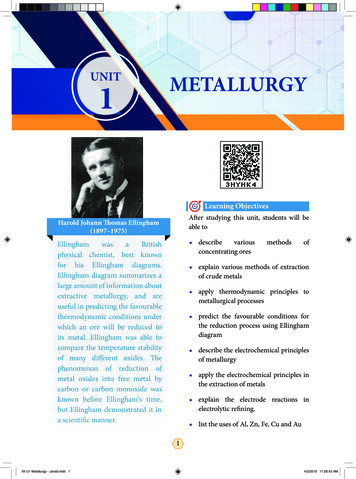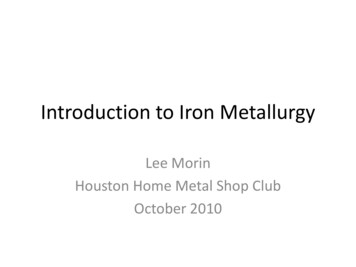
Transcription
Introduction to Iron MetallurgyLee MorinHouston Home Metal Shop ClubOctober 2010
Book I stole the pictures from
We will start with a brief overview!
Metals Are Crystals Fundamental geometry of a crystal is the unitcell– Small box that is exactly repeated as you moveacross the crystal structure Iron has three crystalline structures:– Ferrite: Body Centered Cubic– Austenite: Face Centered Cubic– Martensite: Body Centered Tetragon
Body Centered Tetragonal Unit CellMartensite
Unit Cells in a Lattice - Austenite
Now Add Carbon Solid solutions of carbon in iron are thefoundational technology of our civilization Ferrite can absorb .025% carbon in its’ crystallattice With more carbon you form Fe3C, Iron Carbide Iron Carbide is Cementite Cementite is 6.67% carbon Pure Cementite is too brittle to be useful
If you have less than 6.67% Carbon,you get mixtures With .83% Carbon, you get Pearlite– Fine layers of cementite and ferrite– Looks like an aerial photo of plowed hills
Pearlite1095
With less than .83% carbon, you get:Regions of Pearlite and Regions of FerriteWith more than .83% carbon, you get:Regions of Pearlite and Regions of CementiteBottom Line:At room temperature and at equilibrium, ironcarbon alloys will be ferrite, cementite, pearlite,or mixtures of these.
Areas of Pearlite and Ferrite
Now Add Heat With heating to 723oC or 1333oF:– Pearlite, Ferrite, Cementite are transformed to: Austenite– Can hold much more carbon – up to 2.06%– Only exists at high temperatures in IronCarbon alloys
From a home workshopperspective, 723oC or 1333oF isCherry Red
Just like the phase transformationof melting ice to water holds thetemperature of a glass ofwarming water, the phasetransformation of pearlite toaustenite will hold thetemperature of a block ofwarming steel.
Heating Steel – 1300 Deg F
Heating Steel – 1360 Deg F
Heating Steel – 1400 Deg F
Heating Steel – 1425 Deg F
Certain alloys with other elementsbesides carbon and iron willmaintain the austenite structure atroom temperature so we can see itunder the microscope.
303
Remove Heat Slowly: Austenite reverts to–Pearlite–Ferrite–And/or Cementite Slow heat removal means the phasesor states can come into equilibrium
Remove Heat quickly: Austenite transforms to–Martensite Very strained Very Brittle Very Hard
Body Centered Tetragonal Unit CellMartensite
Mechanical Distortion from Quenching
MartinsiteNeedles
Reheat less and cool in acontrolled way: The Martensite (or some of it)gets converted to:–Pearlite–Cementite–And/or Ferrite The resulting mixture is Bainite
BainiteDarkerthanMartinsite
1045 MartinsiteFerrite with bainite pearlite
One more concept: Grain Size If the grains are larger, the metal is moreductile. More heat results in moreequilibration and more chances for grains togrow. If the grains are smaller, the metal is stronger.Cracks have a harder time propagating acrossgrain boundaries. Less heating and more rapidcooling keeps grain sizes smaller.
Now that we have had the bigpicture overview, we are ready toreview two key diagrams: Iron-Carbon Equilibrium PhaseDiagram Isothermal TransformationDiagram
Start with the Iron-Carbon PhaseDiagram Equilibrium states – shows results from veryslow cooling Plots percent carbon along horizontal axis andtemperature along vertical Any point on the horizontal axis representsmetal with a fixed composition. With a given piece of metal, all you can do ismove vertically by heating or cooling it.
Key Concept about Eutectics: If you freeze a solution with the eutecticproportion, pure eutectic will freeze out. If you freeze a solution with more Y than theeutectic, you will get a mixture of eutectic plusY If you freeze a solution with more X than theeutectic, you will get a mixture of eutectic plusX
Eutectics refer to freezing liquids But similar things happen in solid solutions(like carbon atoms in a lattice of iron) For solid solutions the term is “Eutectoid”instead of Eutectic Concepts are the same
Where is the Eutectic? We see there is a Eutectic on the Iron CarbonDiagram at 4.3% carbon. This eutectic is calledledeburite.
How much carbon can iron hold max? We see the maximum amount of carbon thatcan be dissolved without forming Iron Carbideis 2.06% at 2097 degrees F. Iron alloys below 2.06% carbon are calledsteels. Above 2.06% are called cast irons.
Since we are not interested in working withmolten steel or cast iron for purposes of thistalk, we will limit our attention to the lowerleft portion of the phase diagram.
Remove Heat quickly: Austenite transforms to–Martensite Very strained Very Brittle Very Hard
Where is Martensite on the phasediagram? Martensite is NOT on the equilibrium phasediagram because Martensite is NOT anequilibrium phase. In the Iron-Carbon system,martensite is only formed with rapidquenching, quenching so fast that the crystalstructures cannot get into equilibrium. Itcontains trapped energy in the strained crystalstructures.
Next topic – how to improve themartensite containing steel withmore heat treatment
Annealing and Normalization Heat above transformation temperature– Heat soak one hour per inch of thickness Either Anneal – cool 100 degrees per hour Or Normalize – take out of oven and air coolto room temperature (faster cooling thanannealing) Eliminates or reduces martensite
Process Annealing Heat to relieve stresses in lower carbon steels Prevents distortion from stresses caused bymachining and other work processes Does not form austenite
If we do process annealing with ahypereutectoid steel it is called spheroidizing.
Spheroidizing
Now we are going to talk aboutthe second diagram, theIsothermal TransformationDiagram.
1045 Martinsite Bainite
52100
1060
4140
Silicon9261
General Tempering
Martempering
Austempering
Isothermal Quenching and Tempering
Steel Numbering System4140CompositionPercent Carbon:(100 1%)
Effects of alloying elements on Steel C Carbon – hardness, strength, wear Mn Manganese – Strength, hardenability, heat treatmentresponse Si Silicon – Deoxidation, hardenability Cr Chromium – Corrosion Resistance, hardenability Mo Molybdenum – High Temperature Strength, machinability W Tungsten – High Temperature Strength, wear V Vanadium – Fine Grain, Toughness Ni Nickel – Toughness, Strength Co Cobalt – Hardness, Wear
Introduction to Iron Metallurgy
